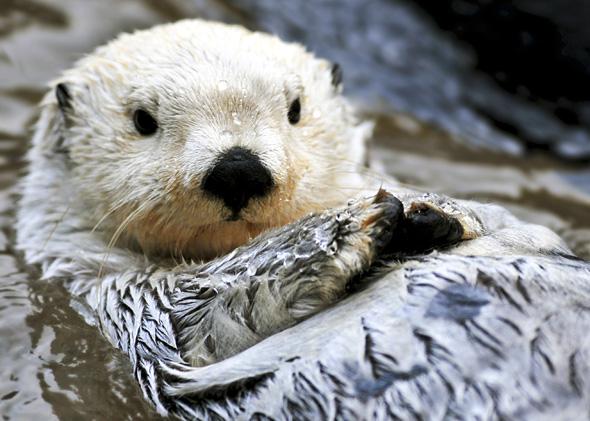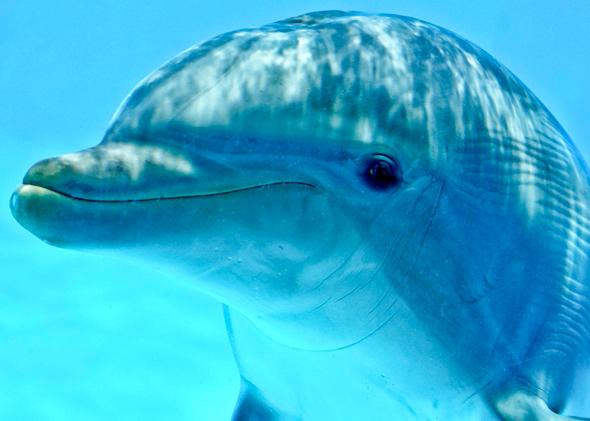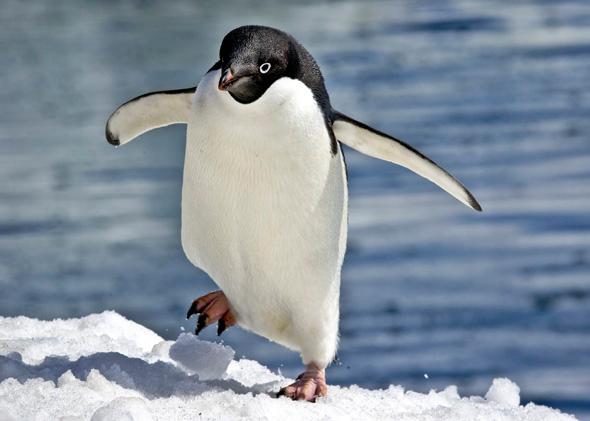I’m going to ruin sea otters for you. Or at least I’m going to tarnish their reputation as some of the most charming little beasties in the seas. For as cute as they are while intertwining paws at an aquarium, frolicking among the wafting fronds of California kelp forests, or smashing sea urchins open with stones, some sea otters have developed the disturbing habit of humping and drowning baby seals.
When I first heard about the behavior from a marine biologist friend of mine, I didn’t quite believe sea otters could be so diabolical. Maybe the bad behavior was just a rumor. But no, the strange sea otter attacks on baby seals are a reality and have even made their way into the technical literature. In 2010, California Department of Fish and Game biologist Heather Harris and colleagues reported 19 individual cases of male sea otters trying to mate with, and often fatally injuring, harbor seal pups in the Monterey Bay, Calif. area between 2000 and 2002 alone.
Delivered in the scientific deadpan required of such papers, the Aquatic Mammals report attributes the incidents to three male sea otters “observed harassing, dragging, guarding, and copulating with harbor seals,” persisting for up to seven days after the otters killed the objects of their misguided advances. The ordeal must have been horrific for the seals. The victims that were necropsied by veterinarians had lesions around the nose, eyes, flippers, and genitals, including perforations in the vaginal and rectal tracts. A painful and confusing end for the poor pups.
Why are these male sea otters killing seals? Strange as it may seem, mating is a relatively common cause of death for female sea otters as well. Male sea otters typically grasp the female from behind and bite her face, and this rough behavior was associated with the deaths of about 11 percent of dead sea otters discovered between 2000 and 2003. Still, the attempts to mate with seals requires an explanation. The identity of a pair of repeat offenders held a clue. At least two of the sea otters had been previously held at the Monterey Bay Aquarium as part of their rehabilitation program for stranded and injured otters. There was nothing obviously wrong with these rehabbed otters, but the trouble they experienced early in their lives might have made them more likely assailants.
Male sea otters compete with one another for mates. If a male can’t find a mate because of his youth or inability to chase off competitors, Harris and co-authors suggest, he might search for a “female surrogate” that may take the form of a young otter or, as in their study, seal pups. This is especially problematic in Monterey Bay, where there are more male sea otters than females. The reason for this skew in the population is unclear, but it leaves male sea otters in a bind. The rehabilitated sea otters were released into an environment of intense competition and were at a disadvantage when it came time to find a mate.
Sea otters are hardly the only marine animals to behave in ways that make us cringe. Seals themselves have been observed to cause similar kinds of trauma when groups of males mob females. But if there’s any marine vertebrate that wins the title of the squickiest, it’s dolphins.
Less like Flipper and more like the megalomaniacal King Snorky of The Simpsons, a dolphin has a permanent smile that gives off a decidedly creepy vibe. Sure, dolphins may now and then help fishermen looking to snag fish, but dolphins’ intelligence and social complexity have endowed them with a suite of behaviors that make them seem less adorable than their carefully-groomed theme park images suggest.
The salty crew of Deep Sea News has been trying to counteract the cuddly image of dolphins for years. Without a doubt, dolphins are jerks. Male bottlenose dolphins will sometimes team up to target a single female and harass her persistently, forcing her to mate with them despite her attempts to escape. And delphine sexual aggression isn’t limited to members of their own kind. Dolphins have tried to force themselves on human swimmers, a prospect made all the more terrifying by the fact that they have prehensile penises. Dolphins kill other marine mammals and fish just for fun and commit infanticide. This only gets creepier given the recent suggestion that dolphins actually have names that they call one another. I can’t say I look forward to the day when scientists discover dolphin slurs. Seeing a dolphin at sea should be just as chilling as how many people feel when they see the sinuous silhouette of a shark.
Shocking behavior isn’t the sole province of marine mammals. One naturalist was so thoroughly disgusted with the sexual behaviors of Adélie penguins that his observations were hidden from view for almost a century.
Known as Pygoscelis adeliae to scientists, and as the Socially Awkward Penguin through memes, the Adélie penguin was one of the subjects that caught the attention of scientist George Murray Levick while he ventured to the South Pole with the 1910-13 Scott Antarctic Expedition. Levick wrote an entire book about the seagoing birds on his return, describing the impression of the elegant avians like so: “When seen for the first time, the Adélie penguin gives you the impression of a very smart little man in an evening dress suit, so absolutely immaculate is he, with his shimmering white front and black back and shoulders.” But the species shocked and horrified Levick so much so that his four-page report “Sexual Habits of the Adélie Penguin” was purposefully omitted from the official expedition findings and distributed only to a small group of researchers considered learned and discreet enough to handle the graphic content.

Photo by neelsky/Shutterstock
While visiting Adélie penguins rookeries, Levick was shocked by the activities of what he called “hooligan cocks.” Males accosted and copulated with other males, females that were injured, chicks that had tumbled from their nests, and corpses. In desperation, some male Adélie penguins tried to mate with the ground until they ejaculated. Levick recorded these behaviors as aberrations from the norm of nature. “There seems to be no crime too low for these penguins,” he confided to his journal.
Later researchers rediscovered what Levick had seen. Rather than being deviant, the behaviors were a regular part of penguin life, triggered by males associating a rather flexible interpretation of a female’s mating posture with receptiveness. As Natural History Museum, London ornithologist Douglas Russell and colleagues reported in a preface to Levick’s belatedly-released report, this behavior is so ingrained that when a researcher set out a dead penguin that had been frozen in such a position, many males found the corpse “irresistible.” In a bit of weird field work, the same researcher found that “just the frozen head of the penguin, with self-adhesive white O’s for eye rings, propped upright on wire with a large rock for a body, was sufficient stimulus for males to copulate and deposit sperm on the rock.” I fear I’ve just made the Socially Awkward Penguin seem just that much more socially awkward.
As Douglas and colleagues stressed in their preface to Levick’s report, though, “the behavior [displayed by hooligan males] is clearly not analogous to necrophilia in the human context.” That fact can easily be lost when one is appalled by an animal acting out a human taboo. Levick was aghast because he viewed the penguins in human terms—as little gents and dames dressed to the nines. The sentiments about proper human behavior were impressed upon the penguins, and vice versa. For if such awful displays occurred in nature, what might that say about our own actions?
What sea otters, dolphins, and penguins sometimes do to one another in their attempts to mate can make us feel queasy, but this is just one sort of animal behaviors that have been unsettling us since the Victorian era.
What we might perceive as aberrant behavior starts early—especially violence. Inside pregnant sand tiger sharks, for example, the first embryo to grow large enough rapidly devours all the other unborn sharks in its shared womb. In other species, post-hatching battles begin almost immediately. Young cattle egrets will peck and harass weaker siblings, going so far to push them out of the nest and to their doom. Such behavior led ornithologist Douglas Mock and colleagues to write “Occasionally, the pen of natural selection writes a murder mystery on the pages of evolution.”
Parents can be as bad as siblings. Among birds, parents under stress to provide for their offspring during rough years may boot eggs from their nests or kill some of their own chicks so that others might survive. As ethologist Sarah Hrdy has observed, there are various reasons for infanticide. Ground squirrels, hyenas, and lions may eat infants of their own species just for a snack. Wannabe mother primates may steal the baby of another and unintentionally starve that infant in a phenomenon called “aunting to death.” Dominant wild dogs may kill the offspring of subordinate members of the pack to make sure the alpha’s infants get the most food. And amorous males of various species, including the noble lion, kill infants to make their mothers available for breeding again. All of this is only the barest catalog of common and widespread phenomena in nature that we often shy away from examining, as we have great difficulty divorcing our own sense of morality from a wilderness that does not and cannot share our values.
The naturalistic fallacy refers to the misguided belief that whatever is natural is good. Natural represents the world as it should be—something we feel estranged from and strive to get back. But this should not be so. Given our ability to reason, we have the unique ability to decide the right and wrong of what we do. It is a grave mistake to see the so-called “depravity” of penguins, dolphins, and otters in the same way as our own behavior.
We shouldn’t draw the curtains over the aspects of animal behavior that make us cringe, as Levick did when he coded some of his Adélie penguin notes in Greek and ultimately decided not to publish his findings. The dark sides of otters, dolphins, and penguins are just as much a part of their nature as the parts we find so squee-inducingly adorable. There is no animal that is made of rainbows and kisses and goodness all the way through.

Photo by eZeePics Studio/Shutterstock
I’m not saying any of this to put down these animals. Given the violence and depravity we’re capable of, we’re not exactly models of morality. Not to mention that we nearly eradicated sea otters out of lust for their pelts, and we continue to keep dolphins confined in small, hard-walled, unhealthy environments for nothing more than our amusement. If dolphins really disappeared tomorrow, as in the Hitchhiker’s Guide to the Galaxy series, I think their final message would be “Screw You” rather than the “So Long, And Thanks for All the Fish” farewell Douglas Adams imagined.
What is natural is not inherently good or evil: It simply is, and we’d be fools to take such examples as models of right or wrong. The dark side of superficially cute animals is a part of their nature that reminds us that the wild does not exist for our entertainment and whimsy. We can find beauty and poetry in nature, but we can also find terror and savagery, all essential parts of the entire picture. Darwin knew this well. (In the concluding paragraphs of On the Origin of Species, he observed that “this view of life” contains grandeur and horror alike.) If we truly wish to appreciate sea otters, dolphins, penguins, and the rest, we need to consider them as they truly are and not just as the cuddly caricatures that never cease to make us go “Awww.”
Elsewhere in Slate, read Jessica Winter’s essay about her dying cat, an excerpt from Jon Katz’s new book about a Rottweiler in need of rescuing, and Jason Bittel’s thorough investigation into bat sex. Previously, Brian Switek has written about mammoth end-times, and how feathery, fluffy dinosaurs killed the brontosaurus.
